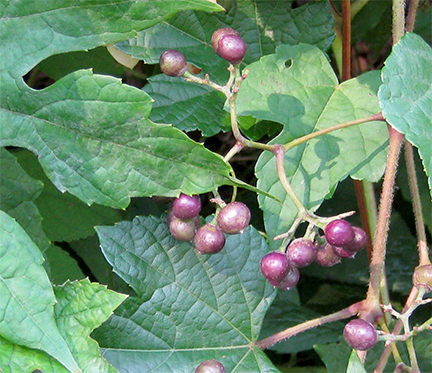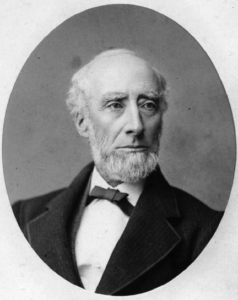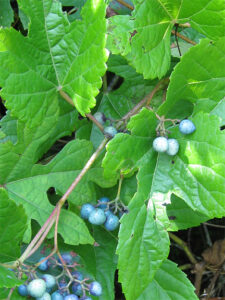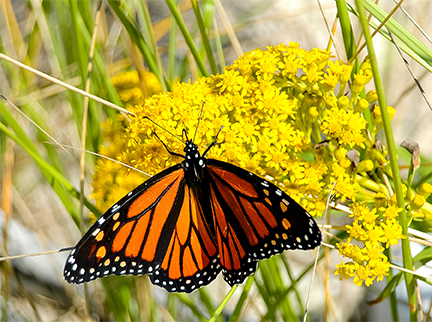By Kate Feiffer

Porcelain Berry, Amur peppervine
If you go to the MassAudubon’s website page for Invasive Plants, you are greeted with this line in large bold print:
“Invasive plants are one of the greatest threats to the nature of Massachusetts.”
“Invasives,” as they are commonly referred to, were often brought to our shores by horticulturalists interested in creating unique and spectacular gardens. Birds and wind further distributed these imported plantings beyond the confines of controlled gardens. Unfortunately many of these eye-catching plants tend to be hostile neighbors, and the MassAudubon’s site warns: “Because they did not evolve in our region, the natural mechanisms that normally control these species in their home ranges don’t exist. As a result, these non-native plants can out-compete, displace, and kill our native species.” It should be noted that there are numerous non-native species found on the Vineyard that are not invasive. What differentiates an invasive non-native species from one that isn’t invasive is its ability to reproduce and its deleterious impact on the environment. To help Sheriff’s Meadow Foundation supporters identify invasive species and to learn about what SMF is doing to control their spread, the SMF newsletter will be running a series of articles focused on the invasive species found on the Vineyard.
Porcelain Berry, Amur peppervine
Japan opened its ports to the United States after the 1854 Treaty of Kanagawa. Eight years later, President Lincoln appointed horticulturalist Thomas Hogg, Jr. as a U.S. Marshall to the Japanese Consulate in Kanagawa, connecting politics to plants in the name of global diplomacy.

Photo of Thomas Hogg Jr. Courtesy of The LuEsther T. Mertz ibrary of The New York Botanical Garden.
Hogg’s family had immigrated to the United States from Scotland in 1820 and opened what is believed to be one of the first nurseries in New York City. While in Japan, Hogg sent back plants and seeds, including hostas, maples, and hydrangeas—all now found on the Vineyard—as well as the eye-catching, yet wildly invasive and pernicious, porcelain berry.
The horticulturist and botanist Peter Del Tredici researched and pieced together the details of Hogg’s involvement in bringing porcelain berry to the United States and published his findings in The Botanical Review in 2017. Del Tredici writes that Hogg’s seeds “were the first specimens of their kind to reach this country and many of them were received here some time before their introduction into Europe.” Del Tredici traced the first documented growth of porcelain berry to a gift received by Harvard University’s Arnold Arboretum. They were “part of the miscellaneous collection of seeds ‘of about 150 sorts’ that Hogg sent.”
The berries for which the plant is named appear in the late summer and fall and look like speckled gems—luminescent robin’s egg blue, pink, and purple in color. They are part of the grape family, but are not terribly tasty, and gained popularity as ornamental groundcover. Porcelain berry is deciduous; it reseeds and grows fast and aggressively, reaching and wrapping, suffocating and stifling. It is one of 140 plants on the Massachusetts Prohibited Plant List. Named the “Weed of the Month” by the Brooklyn Botanic Garden in October 2017, it has been called “Public Enemy Number One!” by Fishers Island Conservancy and “stealthy and insidious” by the Blue Ridge Prism.
So how did it get to the Vineyard?

Porcelain berry, Amur peppervine
According to Kristen Geagan, SMF Director of Stewardship, “Porcelain berry was originally used as a landscaping plant which is how it most likely got to Martha’s Vineyard. Since then it has been spread by birds.”
It is a persistent presence and problem, particularly at Sheriff’s Meadow Sanctuary, and has also been found at Ox Pond Meadow, and West Chop Meadow.
Elizabeth Loucks says “our only meadow property without it is Priscilla Hancock Meadow. I know of a roadside patch at the end of Fuller Street by the beach and a very big patch on Clevelandtown Road across from Schoolhouse Rd. It is scattered throughout some of the Vineyard Haven neighborhoods and is being actively spread by birds.” “It grows voraciously once established,” says Geagan.
“It tends to shade out, weigh down, and out-compete native vegetation, taking away space from others,” explains Loucks. Like the Island’s house sparrow and pigeon populations, porcelain berry is probably here to stay. In order to control growth, Loucks recommends, “selective cutting of porcelain berry back to the root crown because it has a tap root that is very large and hard to dig or pull out as it tends to break off and resprout from the remaining root fragments.” She adds that this technique allows the native plants an opportunity to compete and it limits the light reaching the porcelain berry resprouts. However this strategy requires recutting multiple times per year.
Black Swallow-wort, Cynanchum louiseae

Photo by John Piekos
Known as the murderer of the monarchs and black dog-strangling vine, black swallow-wort, Cynanchum louiseae, looks deceptively innocent. It has glossy green leaves with pointy tips that pair up like best friends. When in bloom, during the early summer, a pageantry of five-petalled purple flowers that resemble little stars cluster together in groups. Later in the summer, long green seed pods dangle down from vines that amorously twist around one another as they extend their reach. A lovely looking plant indeed; black swallow-wort invades fields, crowds out native vegetation, and is on the Massachusetts Prohibited Plant List. And yes, black swallow-wort is deadly when ingested by young monarch caterpillars.
Introduced to the United States from southwestern Europe by horticulturalists in the nineteenth century, there were reports of black swallow-wort “escaping” from a garden in Essex County in 1864 and from gardens in Cambridge three years later. Unfortunately these escapees seem to have caused some significant confusion in the butterfly world.
Monarch butterflies generally lay their eggs on milkweed, which not only nourishes the young caterpillars, it makes them poisonous to their potential predators. According to the U.S. Forest Service, “Milkweeds contain a cardiac (heart) poison that is poisonous to most vertebrates (animals with backbones) but does not hurt the monarch caterpillar.” It’s an advantageous arrangement for the monarchs, and for the rest of the ecosystem that relies on these migratory golden-orange winged pollinators.
Black swallow-wort, in a trick of nature, has emerged as a significant problem because it attracts oviporous monarchs and it is toxic to the monarch caterpillars that feed on it. Since monarch butterflies are important and necessary pollinators, it is crucial to maintain native milkweeds while working to eradicate black swallow-wort. “On Sheriff’s Meadow properties, it’s an ‘early detection/ rapid response’ species because it’s only been seen at only two properties—in Aquinnah and at Nat’s Farm,” says Loucks, who adds, “It’s also established in other parts of Aquinnah, neighborhoods of Oak Bluffs, and in Falmouth. We are also collaborating with the landowners in Aquinnah, where SMF holds a conservation restriction, to remove seed pods in late summer and to cut down the vines.”





